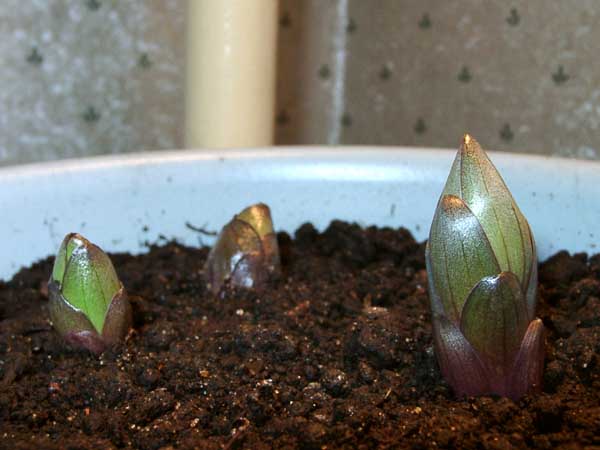Planting lilies in the fall in open ground: when and how to plant bulbs correctly
The magical world of beauty and tenderness opens before us a lily in spring. But in order for a lovely flower to delight us in the warm season, it must have everything necessary for growth and development in the fall. Every active and thinking gardener should boldly introduce into the practice of planting a lily in the fall in open ground.
The advantages of such an event in the fall, the secrets of choosing bulbs, the peculiarities of planting lilies with sprouts, as well as many other intricacies of growing and caring for lilies in the open field, we will tell in our article below.
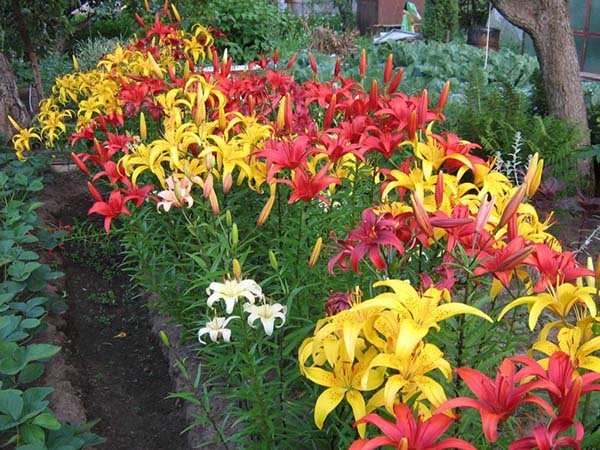
Content
When to plant lilies in autumn: in which month and is it possible with a sprout
The optimal timing for planting lilies in open ground in the fall, of course, directly depends on what climatic zone you live in and on the weather conditions of the season. In short, you need to pay particular attention to how much time remains before the onset of stable cold weather, since on average 2-4 weeks are enough for the rooting of the bulb.
Thus, in the middle lane (Moscow region), lilies are planted in the first autumn month, that is, throughout September. In the south, planting can be postponed until October, but in Siberia and the Urals, this should be landed earlier, that is, in late August-early September.
By the way! The main advantage of the autumn planting of lilies is that before frost it will have time to well develop the root system and bloom the next year, while with planting in spring only through the season.
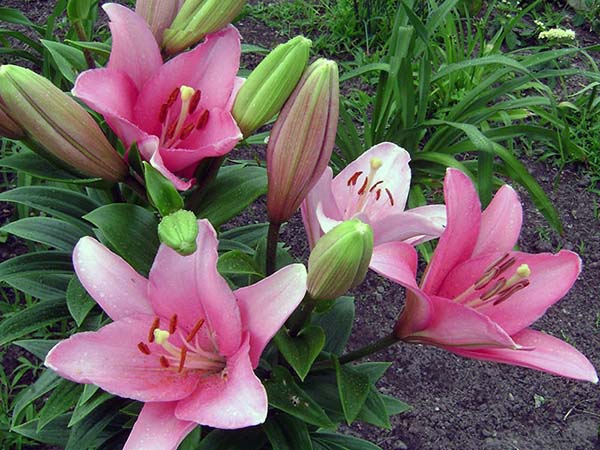
How to choose lily bulbs for planting
It's no secret that a lot, if not everything, depends on the planting material, therefore, to the choice of lily bulbs should be taken seriously... And here's what you should pay special attention to:
- The optimal size (diameter) is at least 3-4 centimeters.
- The bulb should be firm to the touch, if it is too soft and lethargic, then such a copy should not be taken.
- There should be no suspicious stains or molds on the bulb. If there are not many of them, then it's okay, because it is almost impossible to find perfect bulbs.
- Carefully (if possible) inspect the bottom of the bulb, it should not be damaged, and the roots should be in good condition (not rotten).
- Lack of germs.
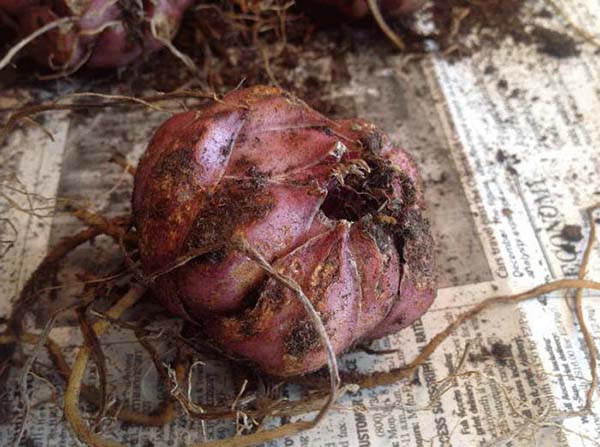
Features of planting lilies with sprouts: timing
Naturally, in late summer - early autumn, nolilies should not have sproutsthey must still sleep. If they are, then most likely, such a bulb has a dormant period, for example, it may have been stored for a long time at low temperatures or there was some other violation in the process and timing of its digging and storage.
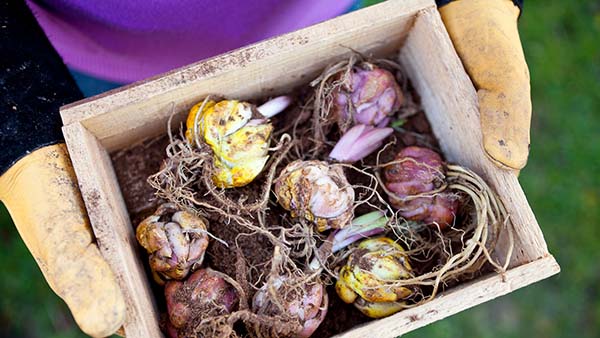
You you can plant such bulbs (with a sprout) in the fall, but with the onset of cold weather, this sprout will necessarily die out, and naturally, there will be no flowering next year. As a rule, after being ill, the plant will bloom, but already in the next season, that is, after 2 years. However, there are exceptions (for example, if you plant very early (in late summer - in August), it can bloom in the same autumn).
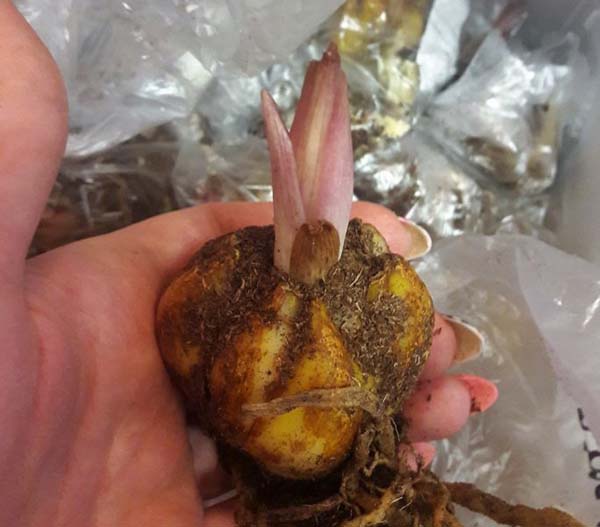
Advice! Some gardeners recommend breaking out, or rather twisting the sprout before planting, so that the plant does not waste energy on forcing the stem, but redirects them to rooting.
If you decide to plant a lily with a sprout in the fall (which was removed), then it is better to do this a little earlier, since such a bulb needs more time to take root (to give roots) and "gain a foothold" in a new place.
By the way! Or you can plant the sprouted bulbs first at home in a pot, where they bloom with you, and then in the spring, along with a lump of earth, transplant into the garden.
But in general lilies with a sprout are planted in the spring.
Video: planting a lily in the fall with a sprout
How to plant lilies in the fall in open ground
Meanwhile, there is not the slightest doubt about the need for accurate site selection and preparation of the required soil.
Seat selection
The place for planting lilies, namely planting them in the sun or in partial shade, should be selected depending on their visible and varietal affiliation:
- La hybrids, tubular and Asian - the sunniest areas are suitable, or very light shading.
- Eastern and martagons - should not be planted in open areas, but select places for them in light partial shade.
You should also take into account the fact that the place for growing lilies should not be too windy, but the air in it should not stagnate, light drafts will only benefit.
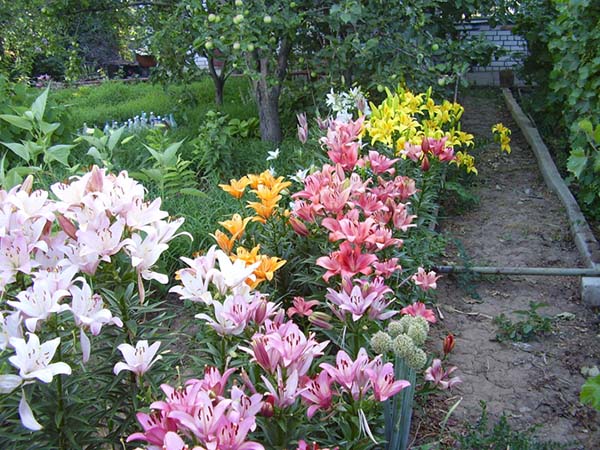
Required soil: how to fill the planting hole
As with any bulbous flowers, lilies require loose, well-drained soil... A heavy one will not work, because the bulb will simply rot in it, and in too light (one sand) - it will constantly lack moisture and nutrition. To improve the structure of the soil, the earth at the proposed landing site should be dug onto a shovel bayonet and peat should be added if the soil is sandy. If the soil is clayey, add sand to the peat.
Important! Lilies do not grow well on acidic soil, for successful cultivation, they need exactly neutral soil. To deoxidize the soil, you should use one of the special deoxidizers, for example, dolomite flour, lime or wood ash.
It will be just fine if you fertilize - fill the planting hole rotted compost. But if you want to use rotted manure, then it must be thoroughly mixed with ordinary soil without fail so that the roots do not burn.
By the way! Now special baskets for planting bulbs have become popular.
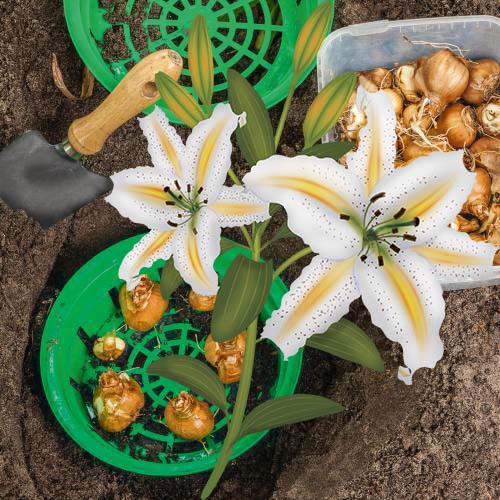
Preparation and processing of bulbs
Before planting a lily bulb in the open ground, you should cut off any roots that are not in the best condition (all dented, lethargic, dry and black). They are of no value, when the bulb takes root, it will give new roots. However, if the roots are well preserved, they are "fresh", then they do not need to be touched, although they can be shortened to 3-5 centimeters to make it easier to plant. It is also worth getting rid of darkened or old scales.
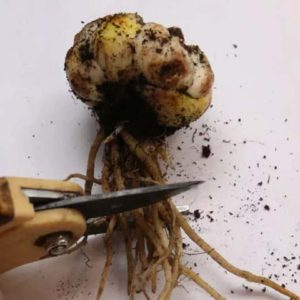
Further recommended process the bulbs in one of the disinfection solutions (protection against fungal diseases), for example, in potassium permanganate or a special preparation-dressing agent - "Maxim Dachnik" or "Fundazol". Etching time is about 20-30 minutes.
Direct landing
Step-by-step instructions for planting lilies in open ground in the fall:
- Decide on a landing site.
- Make a landing hole.
- Prepare the bulbs themselves.
- Pour a little nutritious soil on the bottom of the planting hole, then a layer of sand (drainage, protection against soaking), as well as, if desired and possible, ash (potash fertilizer).
- Press the bulb lightly into the sand, while straightening its roots so that they point in different directions. Some gardeners recommend planting lilies altogether, as it were, in a sand shirt, that is, filling the entire bulb with sand.
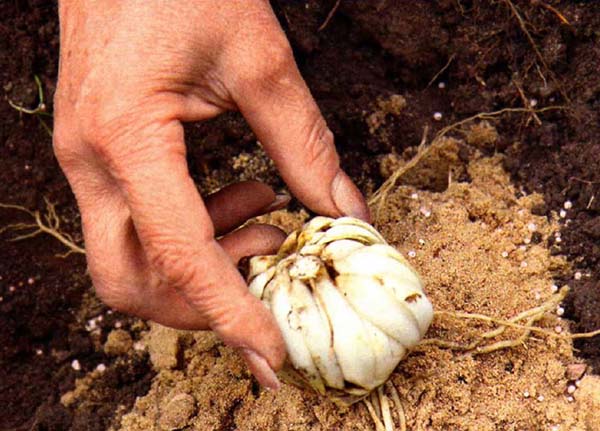
- Planting depth of lilies - 3 heights of the bulb (if the size of the bulb is 4 cm, then the planting depth is 12 cm). Just place one on top of the other and evaluate the resulting height visually, or using a ruler.

- Optimal distance between lily bulbs - 20-30 centimeters.
- Cover with fertile soil.
- Be sure to water abundantly.
- Select a planting site somehow so you don't accidentally forget that lilies will grow here. Better yet, mulch for the winter. If your winters are snowless and harsh, then this is a must.
Video: autumn planting of lilies
Features of planting lily babies in the fall
You will not have to worry about lilies in the spring if you pay attention to the intricacies of planting their children in the fall.
Video: how to plant lily babies in the fall
How to care for lilies: rules for growing outdoors
It cannot be said that caring for lilies in the open field was somehow different from the cultivation of other bulbous flowers, but some of the nuances are still worth knowing and remembering.
Watering
Abundant, but not frequent watering of lilies is required only during their flowering period and in dry hot weather. In spring, lilies have enough natural moisture. At the end of flowering, after a while, watering completely stops.
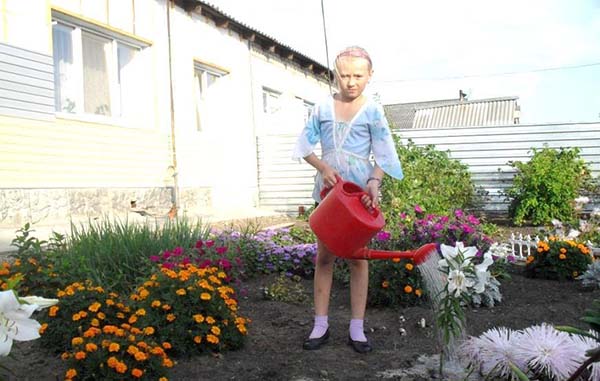
Important! Watering lilies is necessary exclusively at the root. No sprinkling on foliage and flowers.
Top dressing
Lilies respond very well to feeding throughout the growing season. These bulbs are fed, as a rule, according to the following standard scheme:
- In early spring, nitrogen fertilizers are used to accelerate stem germination and build up green mass, for example, ammonium nitrate, green fertilizers.
- At the end of April-May (shortly before the budding period), you can use a complex fertilizer, which includes nitrogen, phosphorus and potassium, for example, nitroammofosku.
- In the summer, immediately before flowering (during the budding period), for a more abundant and lush flowering, the plant is fed with potassium fertilizers, for example, using potassium sulfate or a liquid solution wood ash... Or some special fertilizers for budding and flowering.
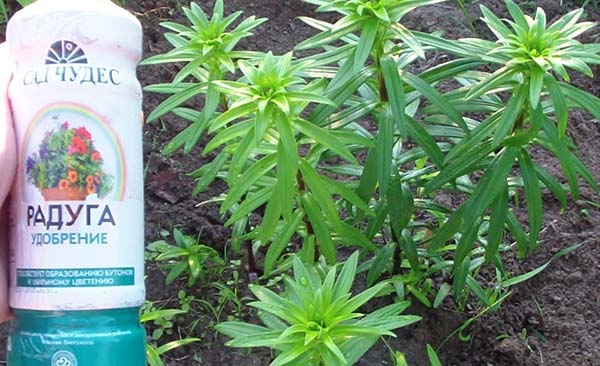
- The final dressing (after flowering - so that the bulbs gain strength) is done with phosphorus fertilizer, for example, superphosphate.
Leaving during flowering
The formation of seeds takes a huge amount of nutrients and energy of the flower, therefore, if you want the flowering of the lily to last even longer, then you should trim the stamens (anthers) and pistils. Moreover, in this way the lily will be able to concentrate all its forces on the formation of roots and daughter bulbs, which means that you can better propagate it.
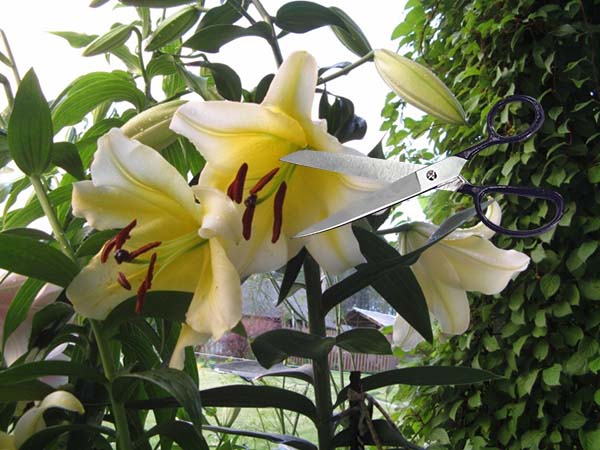
Important! Every 3-5 years preferablydivide (multiply) and transplant lilies, because by this time the nest is growing strongly and the flowers begin to shrink.
Post-flowering care:pruning and shelter for the winter
Note! You can find out all about caring for lilies in the fall and preparing for winter (shelter, pruning) from this article.
So that the florist is happy and the lilies do not suffer, do not let such a serious and responsible event as planting a wonderful flower in the fall take its course. And then inspiring beauty and pleasant aroma are guaranteed to you.
Video: everything you need to know about planting, caring for and growing lilies


